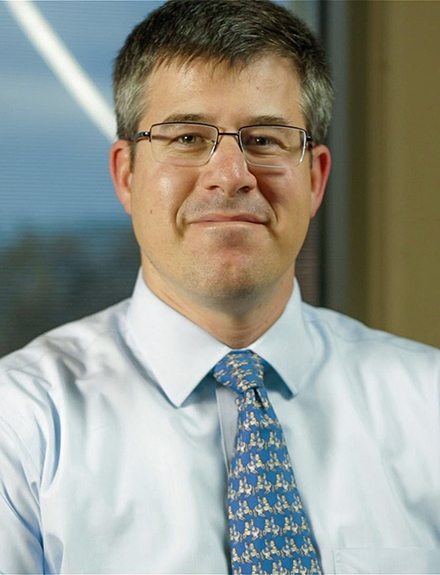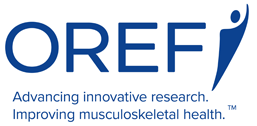

Jeffrey T. Spang, MD
OREF/NSCF Career Development Grant in Stem Cells and Regenerative Medicine
Research Topic
Investigating whether stem cells from adipose tissue could be used in conjunction with a scaffold to build tissues that replicate the natural structure and function of cartilage and bone
Patient Impact
The ability to create cartilage and bone from a patient’s own stem cells to treat and repair damaged articular cartilage
Building a Better Graft
OREF grant recipient explores articular cartilage stem cell treatment
Jay D. Lenn OREF contributing writer
Current surgical interventions to repair articular cartilage often result in less than optimal outcomes because the new cartilage does not sufficiently replicate both the structural and functional properties of healthy tissue. The repairs generally fail to restore the gradient composition of the cartilage-to-bone (osteochondral) tissue—the smooth surface layer of cartilage, the transitional layer of calcified cartilage and subchondral bone.
To address this problem, Jeffrey T. Spang, MD, Associate Professor of Orthopaedics at the University of North Carolina, Chapel Hill, is investigating a strategy to graft stem cells into damaged tissues and guide cell differentiation that promotes more complete osteochondral tissue repair.
Dr. Spang explained, “Our treatment of articular cartilage injuries could be greatly improved. Currently, we don’t recreate the body’s natural function very well. Our scaffold and stem cell research is one step toward building tissue that does replicate that function.”
Dr. Spang’s research is supported by a 2015 Orthopaedic Research and Education Foundation/National Stem Cell Foundation (OREF/NSCF) Career Development Grant in Stem Cells and Regenerative Medicine. This 3-year, $250,000 grant is intended to support the emerging research career of a clinician scientist investigating the clinical application of stem cell research.
How to train a stem cell
In preliminary research, Dr. Spang and his colleagues found that when stem cells were cultured in a cartilage-promoting medium, the introduction of extracellular calcium induced bone generation and inhibited cartilage generation. The controlled levels of extracellular calcium essentially guide stem cell differentiation. Calcium promoted bone growth; the absence of calcium promoted cartilage growth.
In their investigations, the researchers chose adipose-derived stem cells because in a clinical application, it would be relatively easy to harvest these cells from a patient’s own fat tissue. In the OREF/NSCF-funded study, the researchers conducted an in vitro experiment with both human and porcine adipose-derived stem cells. In the final year of the grant the researchers will conduct an in vivo study in a pig model of articular cartilage damage.
One aim of the study is to use 3D-printing technology to create micro-porous three-dimensional scaffolds. The scaffold acts as a framework to hold and organize stem cells. The scaffold is biodegradable and designed to be replaced by the extracellular matrix as tissue develops. The osteochondral scaffold is composed of zones of polycaprolactone with decellularized cartilage extracellular matrix and β-tricalcium phosphate to achieve engineered cartilage and bone portions, respectively.
The novel strategy for recreating the gradient properties of osteochondral tissue is that the scaffold is created with a calcium gradient built into the 3D-printed structure. The bottom layers are “infused” with calcium. As the scaffold degrades, the calcium is gradually released. A tidemark layer separates calcium containing from non-calcium containing scaffold material in the hopes of separating stem-cell differentiation into “bone” sections and “cartilage” sections.
To test this strategy, the scaffolds loaded with stem cells were placed in a growth medium and then assessed for the composition and organization of cells in the new tissue. “Our goal for the in vitro study is to demonstrate that the environment of each section of the scaffold helps cells differentiate into cartilage, calcified cartilage, or bone,” stated Dr. Spang.
Modeling the treatment
In the final year of the investigation, the researchers will test a model of articular cartilage damage in the knee with Sinclair miniature pigs because the joint size, cartilage thickness, and weight-bearing requirements of the porcine joint are similar to those of the human knee joint.
Two small surgically created defects in both knee joints of each of the seven pigs will serve as the injuries. Some defects will either be untreated or treated with an empty scaffold — the control groups. The test groups will be defects treated with an osteochondral plug, and a test group treated with the scaffold loaded with adipose-derived stem cells from the pigs.
“We’ll be looking at two things: how the scaffold performs and how the stem cells perform in that environment,” stated Dr. Spang. “With imaging and histological studies, we’ll look at the integration of the scaffolds into healthy tissue. And we’ll look at how the cells behaved. Are the cells in the cartilage portion making cartilage matrix? Are the cells in the bone end going toward bone? Is there mixing?”
He added, “The ability to create portions of bone and cartilage from the patient’s own stem cells, if we’re eventually proven successful, is going to add a valuable tool for correcting problems we don’t treat well right now."
Preparing for the big leagues
Dr. Spang received his first OREF grant in 2007 during his fellowship in sports medicine at the University of Connecticut, Farmington. “That grant helped me understand what I could do as a clinician scientist and what I couldn’t do. I was able to start working with other people, collaborators who were more senior.”
He noted that this start helped him learn how to find common ground with collaborators, to find projects that excited all of them and projects that tapped into each of their areas of expertise.
Dr. Spang believes OREF’s focus on emerging clinician scientists is one of the grant program’s strengths. It provides resources for junior faculty, residents, and fellows. It leads to mentorships, collaborations, and other funding resources. “It’s important,” Dr. Spang stated. “If you don’t grow the minor leagues, you’ll never have major league contributors."
Jay D. Lenn is a contributing writer for OREF. He can be reached at communications@oref.org.
